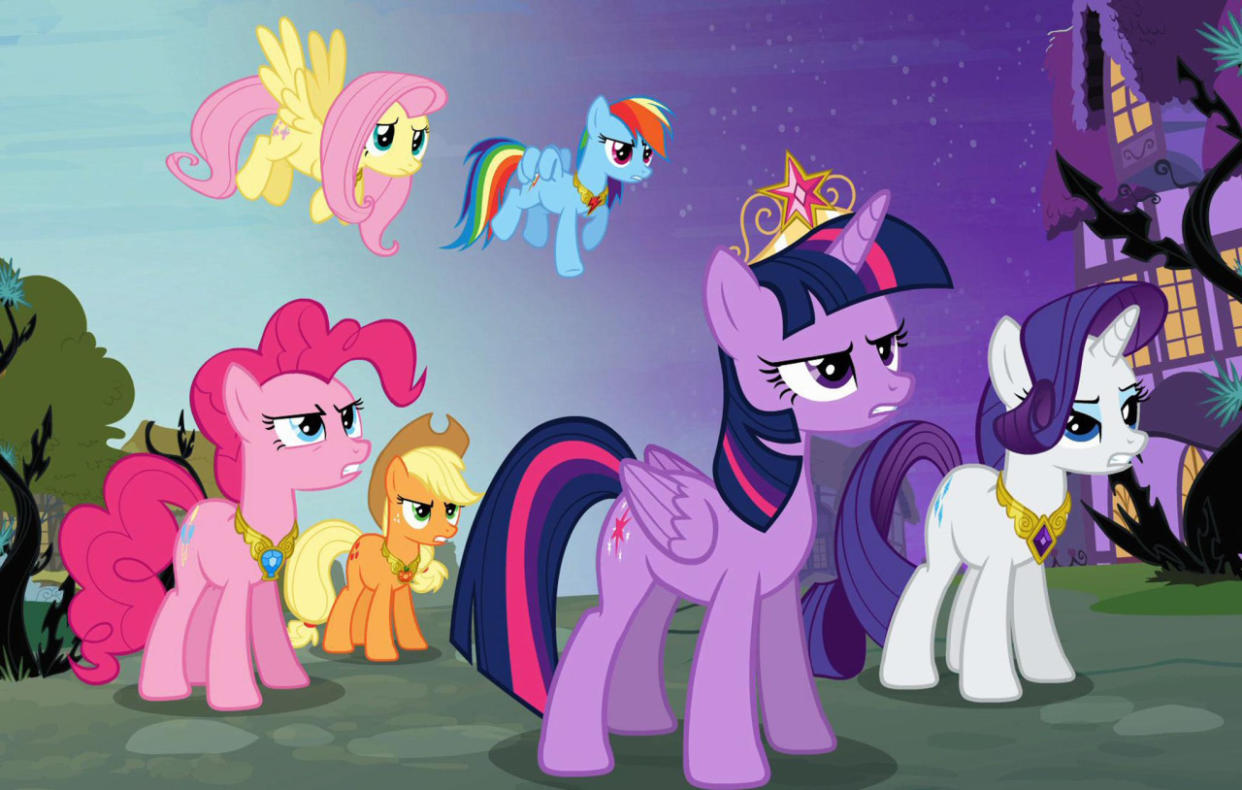A 'My Little Pony' Movie Plea: Don't Forget the Boys

The announcement of a My Little Pony movie is great news for kids like my 6-year-old son, who loves the animated series My Little Pony: Friendship Is Magic. Now approaching its fifth season on the Hub/Discovery Family, the character-driven show is clever, compassionate, and woven with subtle pop-culture references ranging from Saved by the Bell to Sunday in the Park With George. As a result, Friendship attracts a diverse audience, including boys of all ages. Countless trend stories and a recent documentary have chronicled the rise of “bronies,” male fans ages 13 and up who are openly obsessed with the series. (Men aged 18-49 made up 10 percent of the season 3 premiere audience, according to Nielsen.) But the young boys who watch the show, and who are closer in age to its intended audience, tend to be ignored by Hasbro. It’s clear in the marketing: The backpacks and notebooks are pink, the T-shirts are sized for girls, and the toys invariably come with hairbrushes. With the movie, Hasbro has a chance to make amends and embrace its boy fans. But will it?
Conventional wisdom has it that children’s entertainment with a central male character can cross gender lines, while movies or TV shows with a central female character will appeal only to girls. A majority of popular children’s movies thus abide by this rule: The Harry Potter and Shrek franchises, The Lego Movie,and most Pixar films have male heroes. (The major exception is the Disney princess films, which we’ll discuss in a moment.) Furthermore, most of these movies take place in predominantly male worlds, with only a small handful of female characters appearing onscreen. Transferred to the big screen, the universe of animals in My Little Pony: Friendship Is Magic would be an anomaly. All six of the show’s main characters are female ponies. While a few notable supporting characters are male, the fictional nation of Equestria is predominantly populated by female ponies. For someone like me, who grew up watching ’80s cartoons with one or two token girls, this is very exciting. But I can see how the reverse status quo would make film producers nervous.
Here’s what I hope Hasbro doesn’t do with the My Little Pony movie: I hope it doesn’t add a male lead character for the sole purpose of reeling in boys. There is no reason why boys can’t relate to the existing pony characters. Competitive flyer Rainbow Dash and cowgirl farmer Applejack are confident and driven, and they eschew anything girly; unlike their toy counterparts, they most certainly do not own a hairbrush. Animal lover Fluttershy is quiet and nervous yet becomes a force of nature when provoked. Pinkie Pie is characterized by a sense of humor so offbeat that it sometimes mystifies her friends.The central character, Twilight Sparkle, is a magical princess, but she’s also a scholar; the title of princess was bestowed on her largely because she studied really hard. That leaves Rarity, a fashion designer and the most traditionally feminine character of the group. The show frequently uses Rarity to address the question of whether being girly means being weak. (The answer, of course, is no.)

None of these ponies are defined by being “the girl.” Each one has a unique personality and interests that appeal to a wide range of kids. The boys who watch Friendship Is Magic, like 3-year-old YouTube personality That Brony Kid and the 9-year-old who fought to bring his Rainbow Dash backpack to school, have no problem identifying with its female characters. But will movie audiences be able to make the same leap?
If Frozen is any indication, then yes, they will. Traditionally, Disney princess films have been marketed to girls, but Frozen went a different route, emphasizing the film’s male supporting characters (like the comic-relief character Olaf the snowman) in its marketing. It was a risky move, because once those boys sat down to watch, there was no denying that Frozen was a movie about two princesses. Didn’t matter. Frozen became the most successful animated film in history, thanks in large part to its appeal across demographics. According to exit polls, 43 percent of Frozen’s opening-weekend audience was male. Last year, I watched Frozen-mania sweep my son’s kindergarten class, and I can assure you that no child was immune.
The fact that so many boys know all the words to “Let It Go” bodes well for the future of kids’ movies with female protagonists. Another good sign is the evolution of Pixar, which didn’t feature a leading lady in its films until 2012’s Brave. Going forward, the studio’s projects include Inside Out, a movie about a girl and her personified emotions (played by the likes of Amy Poehler and Mindy Kaling); and Finding Dory, a Finding Nemo spinoff focused on the original film’s popular sidekick (voiced by Ellen DeGeneres).
With this project, Hasbro has the opportunity to join the new wave of children’s movies, which acknowledge that girls’ stories matter — and not just to girls. If the producers of My Little Pony can hang on to the great characters and egalitarian spirit of the television series, then the trick will just be getting boys in the seats. (They can even take a cue from Frozen’s marketing department and emphasize humor and goofy sidekicks. Say hello to Spike the dragon!) Plenty of movie producers still believe that male audiences can’t identify with female characters. Maybe My Little Pony, and the youngest generation of movie fans, will prove them wrong.

